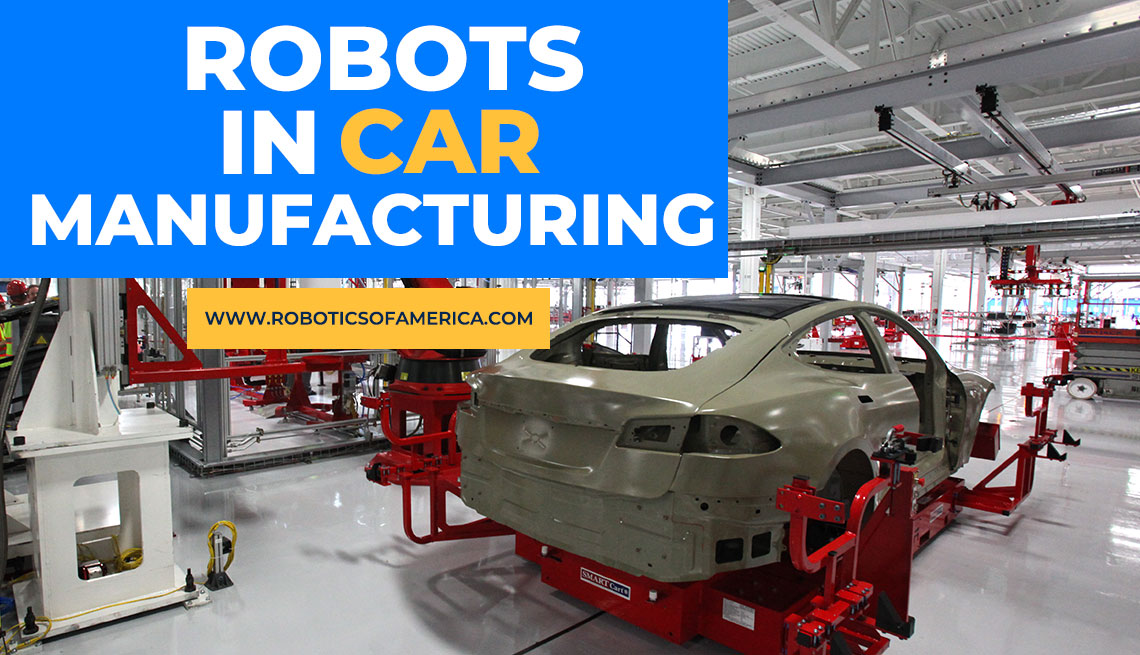
How Are Robots Used in Car Manufacturing?
Many people assume that robots working in car manufacturing are a recent phenomenon. But that couldn’t be further from the truth. Robots have helped build cars for well over half a century. They have been on assembly lines assisting in manufacturing processes.
Automakers are now depending on robotics more than ever before. Why? They are more efficient and accurate than their human co-workers. This leads to production line tasks getting knocked out fast. The automotive industry is one of the most automated industries in the world. This article explores how current robots are benefiting car manufacturers. Let’s jump right in.
8 Ways That Robots Get Used in Car Manufacturing
1) Robots in car manufacturing offer “robotic vision.”
Yes, many robots in car manufacturing can see. Your standard light industrial robotic arm features eyes. The eyes allow the arms to identify what they are picking up. Each robot's wrist features a camera array. (Each wrist also features an advanced laser.) The camera array serves the purpose of providing real-time feedback.
That feedback is useful for more than only the robots. Human operators can also assess what the cameras identify. The instant feedback prevents mistakes from going unnoticed.
Robotic vision also leads to proper offsetting. This is a necessity for when the robots put car parts together. Why? Because the robots can recognize where the parts go without human commands. This leads to fast assemblies offenders, windshields, door panels, and more. So, say you encounter some robotic arms later in life. Keep in mind that the arms could very well be recording your every move!
2) Welding robots contribute to car manufacturing.
Robots in car manufacturing are masters of arc and spot welding. These robots are often very large in size and have long arms. They also have superb payload capacities to conduct spot welding. Spot welding often takes place to create big body panels.
Small robots are part of the car-related welding process too. They contribute to the creation of smaller parts like brackets and mounts. MIG and TIG robots take care of the inert gas operations. (MIG stands for metal insert gas. TIG stands for tungsten inter gas.) These robot-welders are responsible for positioning each torch. This is where the importance of precision comes into play.
Robots are able to position each torch to fit the best orientation. This occurs without any variations whatsoever. The robots’ speed and arc gaps ensure that the welding standards are always high.
3) Robots benefit the assembly lines of car manufacturers.
Robots excel at assembly when it comes to car manufacturing. At least, this is the case in major automotive manufacturing plants. What is the secret to the robots’ assembly-success? Light arms. These arms can put small parts together faster than any human can. Two of the most important small parts are pumps and motors. But don't assume these are the only parts that light robot arms put together. They also take care of windshields, wheel mounts, and screw driving operations.
4) Car manufacturers use robots for painting.
That’s right- robots in car manufacturing are great painters. And they also take care of sealing and coating processes. Why are robots needed for car-painting? Well, a car painter’s job has always been very difficult. One of the key reasons is that paint inhalation can be toxic. To make matters worse, there aren’t many high-skilled car painters in existence. Thus, robotic arms are now the industry standard.
Robotic arms take care of all painting needs fast. Their amazing precision ensures that each paint job is consistent with the others. The robots get programmed to paint in a specific manner. This process covers big areas and ensures that there is little waste. The robots can also spray primers, adhesives, and sealants. Not having to pay human painters has saved car manufacturers tons of cash.
5) Robots in car manufacturing do part transfers and machine tending.
There seems to be no limit to what robots in car manufacturing can do. Here are some more activities that the average car robot is capable of:
- -loading CNC machines
- -unloading CNC machines
- -transferring metal stamps
- -pouring molten metal
Activities like these are too dangerous for most humans. This is especially the case when it comes to pouring molten metal. Why risk human workers getting injured when a robot can do it with no sweat? “Cobots” get tasked with taking care of many small-scale operations and procedures. These procedures apply to machine tending and part transferring.
6) Materials get removed by robots.
Robots in car manufacturing excel at removing all sorts of materials. Sure, their tasks seem complex. But with the right programming, they make these tasks look easy. You see, humans used to fall down while doing trimming and cutting jobs. But car manufacturing robots can always stand up with no difficulty. What is the best type of robot for material-removal jobs? Light robots that use force-identifying technology. This technology allows each robot to perform tasks such as:
- -cutting fabric
- -polishing molds
- -trimming flash off of plastic moldings
7) Car manufacturing robots are masters of internal logistics.
AMRs contribute to car manufacturing for internal logistics purposes. What is AMR? It stands for autonomous mobile robots. In other words, an AMR is an automated vehicle.
For example, a robotic forklift counts as an AMR. An AMR forklift transports raw materials across car factories. But they do not only transport raw materials. They can also move plenty of other car parts from place-to-place.
Ford Motor Company has developed a strong reputation for using AMRs. Let’s use its car manufacturing plant in Spain as an example. The Ford AMRs in Spain use technology derived from MiRs. What is MiR? It stands for Mobile Industrial Robots. The Ford AMRs can transport welding and industrial materials. They bring the materials to different stations across the factory floor. This has saved Ford so much time compared to using an outdated manual-process.
8) The collaborative robots of car manufacturing make a difference.
Robots in car manufacturing have a strong reputation for their collaboration techniques. In other words, factory robots are able to work with different types of robots. You can witness these robotic collaborations across most car assembly lines. Some of the robots specialize in welding. Others specialize in handling. These unique roles contribute to the success of each assembly line.
Many assembly lines are huge. That is why the collaboration of industrial robots is so important. Say for instance that robot-welders and robot-handlers were not able to collaborate. This would mean each assembly line would come to a complete halt. One robot’s job puts the next robot in a position to do its own job. For example, robot-handler places panels in exact locations.
Why? So that the robot-welder gets positioned to perform it’s own welds. In fact, robotic welders are the number one type of robot in the car manufacturing industry. And they have been for decades. This is due to each assembled car needing tons of welds during production.
The Future of Robots in Car Manufacturing
Robots in car manufacturing are not going anywhere. They are here to stay. Why? Here’s the key reason. Car manufacturing is getting more automated by the day. In fact, many manufacturing sectors have become automated, across many different industries.
Car manufacturers do not need many human workers any longer. The need for humans in the auto industry is going to continue to decrease in the coming years.
Do not assume that humans are extinct from car manufacturing. Companies are still employing some humans to work alongside robots. This is due to many reasons. What’s one of the biggest? Humans can still reach certain areas that robotic arms cannot. But keep in mind that robotic technology is continuing to improve. This means that the car manufacturing industry is going to get more automated over time.
Once full automation occurs, there will be very few human workers in factories. In fact, most future human car manufacturing jobs won’t have to do with the cars themselves. The jobs will involve ensuring that the robots are performing their tasks well. Robots will need to get programmed, maintained, and repaired. These three key actions are what humans will be doing.
Conclusion: How Are Robots Used in Car Manufacturing? Tons of Ways
There are very few limits to what robots in car manufacturing can do. And in the future, there will be no limits. But that will only be the case once full automation is possible. No one knows the exact year that this will occur. But it could be very soon.
That's why we must accept that robots are here to stay. Feel free to browse our website for more content about robots in car manufacturing. Robotics of America is your key destination for robot information. We plan to soon release more content about:
- -advantages of robots in car manufacturing
- -how has robotics changed manufacturing technology in the automotive industry
- -robotics in automobile industry PDF
- -disadvantages of robots in car manufacturing
- -automation in the car industry
- -car manufacturing robots price
- -robotic process automation in the automotive industry
- -5 applications of robotics

